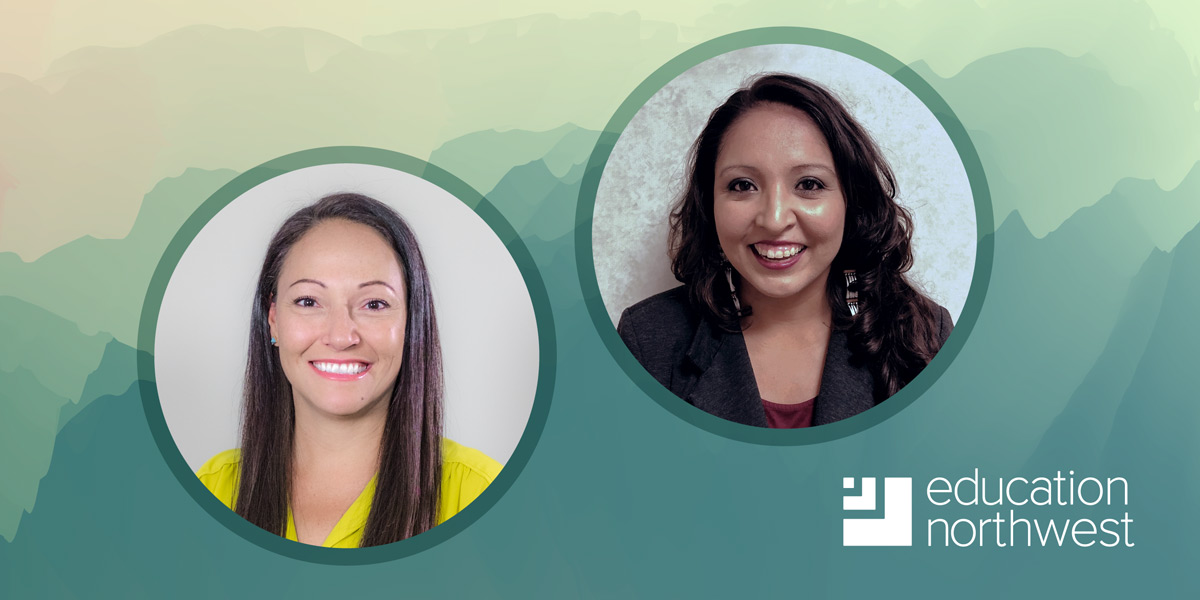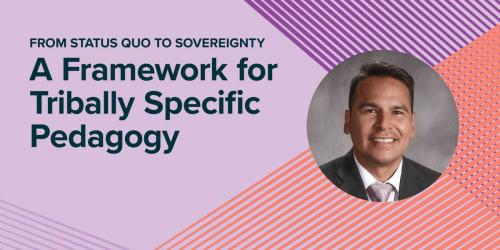Networks of Care: A Conversation About Conducting Trauma-Informed Work in Native Communities

Maegan Rides at the Door (Nakota/Dakota/Absentee Shawnee) is the director of the National Native Children’s Trauma Center in Missoula, Montana. Maegan joined the Education Northwest Governing Board in 2020. She sat down with Mandy Smoker Broaddus (Fort Peck Assiniboine and Sioux), Indian Education practice expert at Education Northwest, for a conversation about making trauma-informed work culturally responsive to the needs of American Indian or Alaska Native children and communities.
Mandy Smoker Broaddus (MSB): The National Native Children’s Trauma Center (NNCTC) does amazing work. Can you talk about why it’s so important to take a culturally responsive approach to addressing the needs of American Indian or Alaska Native children who have either directly experienced trauma or for whom trauma is part of a community experience or a family experience? How do you talk about that and describe that to people in the field?
Maegan Rides at the Door (MRTD): A lot of things that are developed for working with children who have experienced trauma do not have American Indians in mind. Typically, things are conceptualized outside of our communities. What NNCTC tries to do is integrate our Native knowledge and context into that work. For example, a lot of people are developing trauma-informed, responsive systems of care, but then only thinking about the cultural context after the fact. It’s really important to be thinking about that from the beginning, as you are developing the programs or even as you are first conceiving them: What will this mean for our Native communities? What will work for these populations?
MSB: How would you describe the distinction between social and emotional learning and trauma-informed work?
MRTD: They definitely overlap, and they accomplish some of the same things; where they diverge is the purpose behind it. With trauma-informed work, you are intentionally creating social and emotional learning specifically for those who have experienced trauma. We use the term trauma broadly. There are so many kinds of trauma that a student or youth can experience. It’s really about being intentional and thinking about the ways in which you teach social and emotional learning to a student.
MSB: Can you give me an example?
MRTD: So, what is up-regulating and down-regulating for a child? Sometimes an adult might think that dimming the lights and having a relaxation session would be soothing, but that’s actually up-regulating for some students who have experienced trauma and may not be comfortable in the dark or closing their eyes around others. Some students may not be comfortable in some situations in which we are trying to teach them to regulate their emotions. So, it’s really about recognizing the potential trauma reminders and thinking about alternative ways we can teach these things to those youth, specifically.
MSB: Have you seen a growing awareness among educators and communities of the need to be engaged in this work?
MRTD: Oh, definitely. I think that there could be—and should be—multiple Native children's trauma centers across the country. That’s why it’s so helpful that Education Northwest and other organizations are contributing to this work, because it’s so needed and there are not enough entities to meet those needs. I mean, typically, we do not really market our services because we don’t have to. People are always reaching out to us, either for help with one-time trainings or for longer-term partnerships.
MSB: I've been to quite a few ACEs [adverse childhood experiences] trainings in my career, and I have often heard from educators, ‘OK, we intuitively knew that these experiences existed. Now we can put a number to it and describe it and have language to work with.’ But then they are like, ‘What do we do now? What’s the next part?’ What do you tell educators when you get that response?
MRTD: Yeah, I think that’s where a lot of people are at—they want an outlet. ‘What do we do? How do we start?’ And I think that’s really a dynamic and complex process. I think in our world right now, we all want a quick fix. We want the best evidence-based strategy that is going to fix this and give us that instant gratification. The reality is that trauma can really affect someone’s whole being. And when we think about multiple children or communities who have experienced trauma—it’s very difficult to find a quick fix for these comprehensive problems. That’s going to require a comprehensive and sustained approach. You’re not going to fix that overnight. It’s going to take a communitywide, cross-system approach that really reverberates. And I would say that some people get overwhelmed with thinking about all that—thinking about it on a larger scale—and they tend to focus on things they can do individually.
MSB: And that can be valid, right? Even if it’s not ideal?
MRTD: Yes, there are definitely things people can do individually. And they should feel empowered to move forward with this work if that’s the only way to move forward. There’s really a continuum of things we can do, from what individuals can do on their own to what a communitywide process can do. I think the most powerful approaches are those that have appropriate community decisionmakers at the table and are co-creating these strategies and are not about one person—or one organization—creating it on their own. The right of a community to choose the treatment or the strategies they want to bring into their school system or their community—even if that treatment is ultimately provided by an outside entity—is really powerful to acknowledge and can be healing in itself. I know you’ve experienced that.
MSB: Absolutely. I have found that in all my work—the importance of gaining some understanding of a community and working to empower that community to find its own way forward and to tap into the resources and strengths it already has. Whether that’s a group of educators in a school, a Tribe, or a group of students, it’s so important to learn as much as you can about who they are, the place they’re coming from, and to create an opportunity for dialogue. Ultimately, the goal is for them to take ownership. I want them to be able to grow their own capabilities and capacities from within because they have it there—they have everything they need. This is making me think about the training model you have for middle school students. Can you talk about that?
MRTD: That’s CBITS [Cognitive Behavioral Intervention for Trauma in Schools]. We have been working with the developers to publish a version of CBITS that is specifically designed for American Indian youth. It should be published this year by the Rand Corporation. And then we’re also working with the developers of Bounce Back, which is the elementary-level version of CBITS. And they have allowed us to create lesson plans [for Native students] based on the Bounce Back template, so that teachers can draw on some of the same lessons they’re already using, just redesigned specifically for cultural relevance.
We’ve been trying to develop products that don't require a mental health professional—products that teachers and other professionals can use in the community, whether it's in the juvenile justice system or other systems that have people who are willing to take on that role. We find that these systems are more likely to continue implementing the model if it doesn’t require a mental health professional. That’s been a really big challenge: How can we create things that have a lot of value to them, a lot of depth, but don’t require a mental health expert to implement?
MSB: Right. When I was at OPI [the Montana Office of Public Instruction] and we first began providing wraparound services on several of the reservations in Montana, we were looking to hire service coordinators who were members of the community. I was overwhelmed to discover that who we ended up hiring—it was always Native women who were already the go-to people in their community if you were in crisis. It was not typically a mental health professional. There were those few people in the community you went to, whether you were a kid or an adult. So, you build on that.
MRTD: Exactly, there is almost always some level of support that already exists in nearly every community and particularly in Native communities.
MSB: And if you can give those members of the community the additional tools—the kind of tools you’re talking about—it helps the community grow and heal and they get to spread that among all the people they interact with. I love those community models, where you plant the seeds and give people the resources and the tools, not just because it’s needed but because it’s already a part of our networks of care, I think, as Tribal people.
MRTD: Exactly. It’s so encouraging to see that happening. It’s about acknowledging the strengths that already exist in our Native communities and building on those strengths and co-creating the work. It sounds like common sense, but as you know, that is not the approach that has typically been taken by those coming into Native communities from the outside. The NNCTC is attempting to address that gap, and I’m so glad to see other organizations, like Education Northwest, who are also taking that approach when working with Native communities. It is real progress.



